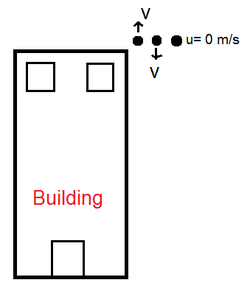How much Time?
 A Ball thrown upwards from the top of a building takes 9 seconds to reach to the ground. The same ball when thrown in downwards direction with the same initial velocity takes 4 seconds to reach to the bottom. How much time will the ball take to reach the ground if it is dropped from the top of the same building?
A Ball thrown upwards from the top of a building takes 9 seconds to reach to the ground. The same ball when thrown in downwards direction with the same initial velocity takes 4 seconds to reach to the bottom. How much time will the ball take to reach the ground if it is dropped from the top of the same building?
The answer is 6.
This section requires Javascript.
You are seeing this because something didn't load right. We suggest you, (a) try
refreshing the page, (b) enabling javascript if it is disabled on your browser and,
finally, (c)
loading the
non-javascript version of this page
. We're sorry about the hassle.
4 solutions
Discussions for this problem are now closed
@Aman "v=u-gt(opposite direction) and at the maximum height v=0 so t=u/g and for the for returnig to top of the building t'=u/g. So total time taken is T = t + t' = 2u/g.
The time taken for the ball to return to the top after it is thrown up with a velocity 'u' will be (2u/g). Now the ball has the same velocity 'u' but now towards the ground. Hence, the time taken henceforth to reach the ground will be the same as if it were thrown down with the same initial velocity 'u'. So we get an equation over 'u', i.e. => (2u/g) + 4 = 9 Solving for 'u' we get u = 25 m/s. Now we put this in for the equation s = ut + (at²/2) => and find the height of the building. Now we equate this with the expression for distance covered for free fall i.e. s = gt²/2 and finally get the time taken for free fall !! The final equation comes out as T² = 36 where T is the required time and hence T = 6 s .
Simple formula T=root(T1T2)
That works for this case but does it works in all such sums ? I would really apreciate if u can give theoretical proof...
Here's your proof buddy.
Let h be height of the tower and t 1 be time for first case and t 2 be time for second case and t be time for the last case.
For Particle 1:
− h = u t 1 − 2 1 g t 1 2 (eq. 1)
For particle 2:
h = u t 2 + 2 1 g t 2 2 (eq. 2)
For Particle 3:
h = 2 1 g t 2 (eq. 3)
When you eliminate u from eq. 1 and eq. 2(I believe you can do that?), you get:
h = 2 1 g t 1 t 2 (eq. 4)
And then by equating eq. 3 and eq.4 we get:
t = t 1 t 2
Hence proved.
I used 9.8 as acceleration and got a wrong answer
how 2u /g has come
If it s thrown up with initial velocity u then it takes a time t=u/g to reach the top (using v{f}=v{I}+at) so does take to return back to point from where it was thrown,hence total time will be 2t I.e 2u/g
s = ut + (at²/2)
H=-v * 9+(1/2) * g * 9^2
H=v * 4+(1/2) * g * 4^2
Eliminating H we have v * 4 + (1/2) * g * 16=-v * 9+(1/2 ) * g * 81
Simplifying we have v * 13=(1/2) * g * 65
which then yields v=(1/2) * g * 5
Substituting in an equation for H we have H=(1/2) * g * 5 * 4+(1/2) * g * 4^2 = (1/2) * g * 36
t=36^(1/2)=6
When the ball is thrown upwards:
h = − 9 v 0 + 5 × 8 1 ( α )
When the ball is thrown downwards:
h = 4 v 0 + 5 × 1 6 ( β )
So:
4 v 0 + 5 × 1 6 = − 9 v 0 + 5 × 8 1
⟹ 1 3 v 0 = 5 × ( 8 1 − 1 6 ) = 5 × 6 5 = 3 2 5
⟹ v 0 = 1 3 3 2 5 = 2 5
Plugging the value of v 0 into ( α ) or ( β ), we can discover the height, which is 1 8 0 . Knowing the height, we can discover the time the ball will take to reach the ground when dropped by doing this:
1 8 0 = 5 t 3 2
⟹ t 3 2 = 3 6
⟹ t 3 = 6 seconds.
This is how I solve the problem.
d = V * 9 - (1/2) * g *9^2 .........I .
d = V * 4 - (1/2) * g *4^2 .........II
V = (1/2) * g * 5........................III
Substituting III ..in.. II
d = (1/2) * g * 36
t = sqrt(36) = 6.
Guys for problems like this there is a simple formula … Well I'd like to bring forward Kanishq Goyal's idea, its the same as mine.
Where in a situation like this T 1 be the time taken by a ball thrown up from a height with initial velocity, u
....and T 2 be the timw taken by a ball thrown below from the same height and initial velocity, u , then …
T 3 , i.e. the time take if the ball is simply dropped from the same height = T 1 ⋅ T 2
There you go! and get T 3 = 9 ⋅ 4
⇒ … T 3 = 6
Over and out … :)